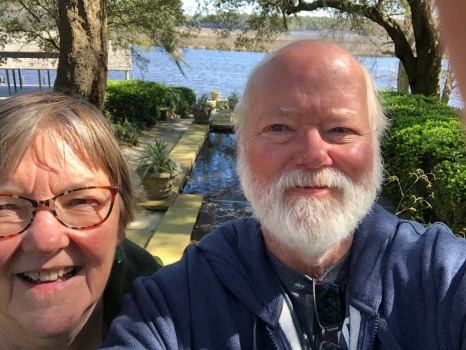The Keweenaw Peninsula is home to copper mining in this part of Michigan. Copper mining was actually done in many parts of the Upper Peninsula, on Isle Royale and on the North Shore of Lake Superior in Minnesota. The really big successful mines are north of Houghton. The expansion of telegraph lines and the introduction of electrical power in the 1800’s increased the need for copper. We visited two of the mines.
The Quincy Mine is right in Hancock just across the river and up the hill. This mine started in the mid 1800’s and was in production up until the Great Depression. That shut it down and when things got better so much of the mine had flooded that they just closed it down. Copper mines in Michigan produced about 11 billion pounds of copper. The leader of the Quincy Mine tour said that they estimate that less than half of the copper has been removed.
We had to wear hard hats and jackets to look like miners for the tour.
We started in the remaining hoist house where immense steam engines drove a giant steel drum that had more than 3 miles of 1-1/2″ cable wound around it and threaded into the mine shaft.
The two ends of the cable went up to the shaft house and down more than 9,600 feet following the sloped mine shaft to the more than 60 levels where side shafts went off in to the hard rock looking for copper. Several different types of cars rode up or down the rails in the shaft. Some hauled water, some ore, some miners depending on what needed to be moved. Miners rode down in a 30 man car with no lights and the top of the shaft just inches from their heads. The bottom of the mine was more than 6,000 ft below the surface. There are more than 320 miles of tunnels following the copper deposits in this mine.
We rode down a steep inclined railroad to a drainage tunnel that lead into level 3 (of more than 60).
The tunnel has been enlarged by students from Michigan Tech University’s mining school while learning how to drill and blast. Boy, I would have like to have had that class. Now with and enlarged tunnel an electric tram can carry visitors into an underground area to see how mining was done. It actually passed by a classroom for the mining students blasted out of solid rock..
At first the mining was mostly all done by hand in the very hard rock. Later powered drills and TNT improved productivity. There was almost no safety equipment. An injury ended your career. Most miners did well to last 20-25 years in the mines. Every level below level three is flooded.
The early miners used candles for light that they had to buy themselves. So often a crew of three would only use one candle while one miner held the steel drill and the other two hit it with sledge hammers. Four holes, two feet deep took this crew two 10 hr days to complete. Some black powder packed in the holes made some small headway into the rock. Not a job I would have wanted.
It is amazing how hard these miners worked and how hard the work was.
We also visited the Central Mine which closed in the 1890’s. Susan’s early relatives worked at this mine. It was a very productive mine and had an entire town built up around the mine for the 1200 miners. Most of it is gone now except for a few buildings and sites.
We had to laugh at the visitor’s center. It was closed when we got there and in what must be Yooper Language, the sign said “Shut”. A peek through the window revealed wooden floor boards that were probably 16″ wide.
Later the sign said “Open” and we got to have a look at the historical displays.. They have a picnic here every year for descendants of the miners, lots of people attend.
The drive home along the lake shore found some nice overlooks. The South Shore is really pretty nice.
Sorry about how some of this looks. Try to do this blog on the iPad – it looks one way. Try to do this on the laptop – it looks completely different, different fonts, different picture placement. and then it gets published and it doesn’t look like either on the blog and if you are getting the email feeds, it looks different there as well. If you are going to do a blog start with WordPress or anything other than Google Blogger.
More later
Roger and Susan









